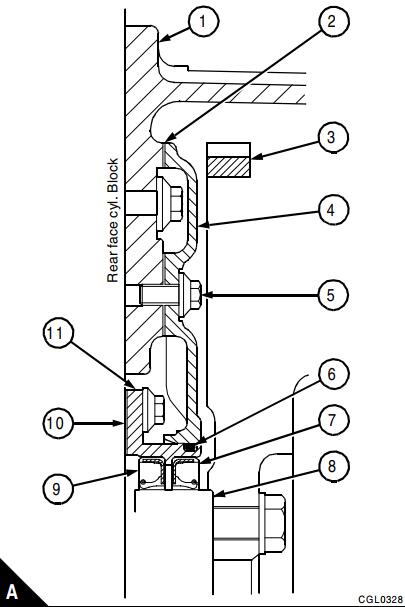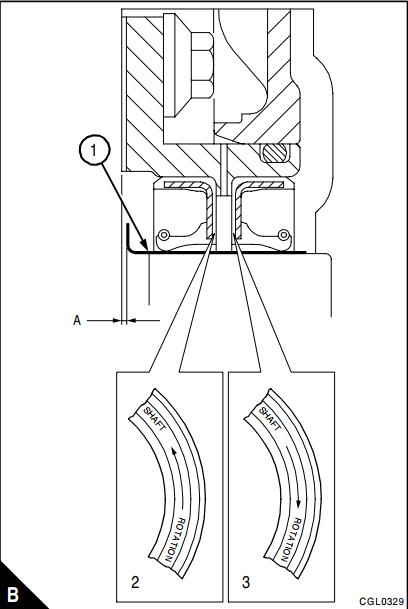Crankshaft rear oil seal arrangement for engines which use a wet back end
A new arrangement for the crankshaft rear oil seal has been introduced for engines which use a wet back end. This arrangement uses two lip seals which are narrower than the standard seal and operate back to back on the crankshaft palm.
Related Contents:
Perkins EST 2024A & 2023A & 2019A Software Free Download
Perkins SPI2 2018A EPC+Service Manual Free Download
The front seal (A9) prevents leakage of oil from the engine and the rear seal (A7) prevents leakage of oil from the flywheel housing. A cover (A4) and joint (A2) are used to prevent leakage of oil past the setscrews which retain the flywheel housing (A1) to the rear face of the cylinder block. An O-ring (A6) is used to seal between the cover and the seal housing.
Oil leakage past the O-ring or one of the oil seals will pass through a hole in the seal housing between the two seals.
The oil will then pass through two cast grooves in the front face of the flywheel housing. These grooves are in the 4 o’clock and 8 o’clock positions.
To remove and to fit the rear oil seal assembly
1 Release the setscrews which retain the flywheel and remove the flywheel (A3).
2 Release the setscrews (A5) which retain the cover (A4) and remove the cover. Remove the joint (A2) and clean the joint faces of the cover and flywheel housing.
3 Release the setscrews and the cap screws and washers which retain the housing (A11) for the rear oil seals and remove the housing.
4 Clean the joint faces of the seal housing and cylinder block.
5 Clean the crankshaft palm (A8) and check for wear
in the seal location areas. If there is wear, a “SpeediSleeve”, part number 21825188, can be fitted. Refer to the procedure given on page 4.
Note: If a “Speed-Sleeve” is not available the crankshaft palm can be machined to give a minimum diameter of 133,17 mm (5.243 in). Do not machine the last 2,5 mm (0.10 in) of the crankshaft palm as this is necessary for flywheel location.
Caution: A “Speedi-Sleeve” must not be fitted if the crankshaft palm has been machined undersize.

6 Ensure that the dowels for the oil seal housing are fitted in the cylinder block. Put a new joint (A10) in position on the dowels, no jointing compound is necessary.
7 Put the seal guide, which is used for standard seals, on the crankshaft palm. Lubricate lightly the crankshaft palm, the seal guide and the lip of the seals with clean engine lubricating oil.
8 Put the seal and housing assembly onto the seal guide and carefully push the assembly onto the dowels. Remove the seal guide, fit the setscrews and the cap screws together with their washers.
9 Tighten the setscrews to 22 Nm (16 lbf ft) 2,2 kgf m and the cap screws to 13 Nm (10 lbf ft) 1,3 kgf m.
10 Fit a new O-ring (A6) in its recess in the seal housing and lightly lubricate it with clean engine oil.
11 Apply a suitable jointing compound to one side of a new cover joint to hold the joint in position. Put the joint in position on the flywheel housing. Put the cover into position on the joint and fit the setscrews.
Note: New setscrews have a sealant applied by the manufacturer. If these setscrews are to be used again, the threads of the setscrews and the threads in the flywheel housing must be cleaned. A suitable sealant, for example POWERPART Threadseal,must then be applied to the setscrew threads.
12 Tighten the setscrews to 22 Nm (16 lbf ft) 2,2 kgf m.
13 Ensure that the location faces of the flywheel and crankshaft are clean and free from damage. Fit the flywheel and the setscrews together with their washers. Tighten the setscrews to 105 Nm (77 lbf ft) 10,7 kgf m.
14 If the starter motor is removed from the engine,clean the flange face of the starter motor and the face of the flywheel housing. Apply a 2,0 mm (0.080 in) continuous bead of POWERPART Hylosil to the flange face of the starter motor near to the spigot before the starter motor is fitted.
Caution: If the engine is to be operated before oil is added to the flywheel housing, the rear oil seal must not be fitted until after the engine has run.

To renew the rear oil seals
1 Remove the seals from the housing with a suitable tool used as a lever. Ensure that the seal housing is not damaged. Do not try to press the seals out of the housing as there is a shoulder in the housing (B).
2 Clean thoroughly the oil seal housing. Inspect the oil seals for damage. If only a small scratch can be seen across the lip of the seal, do not fit the seal.
Note: Before the oil seals are fitted into the housing ensure that the correct seal is fitted to the correct side of the housing. Each of the seals has an arrow on the flat face of the seal. This arrow indicates the correct direction of shaft rotation for the seal, see (B2) and (B3).
3 Lubricate lightly the outer circumference of the front oil seal and the bore of the housing for the front seal with clean engine oil.
4 With the flywheel side of the seal housing on a suitable support, press the new front seal into the housing. Use a suitable tool which will apply pressure only to the flat inside face of the seal.
Caution: Use only enough pressure to ensure that the flat face of the seal is against the shoulder in the housing. Too much pressure could damage the shoulder.
5 Lubricate lightly the outer circumference of the rear oil seal and the bore of the housing with clean engine oil.
6 With the engine side of the seal housing on a suitable support, carefully press the rear oil seal onto the shoulder in the housing with the same tool as for the front seal. Ensure that the seal is against the shoulder in the housing.
Caution: The rear oil seal must not be fitted if the engine is to be operated before the oil is added to the flywheel housing. The seal must be fitted with the seal housing in situ after the engine has been run.

More Perkins case,please refer to:Perkins Engine Trouble Repair